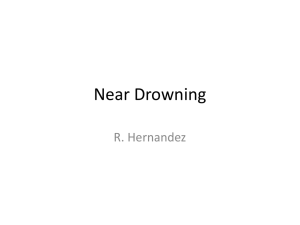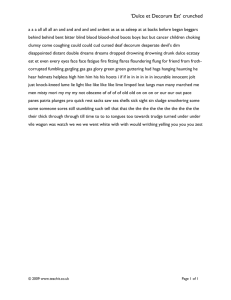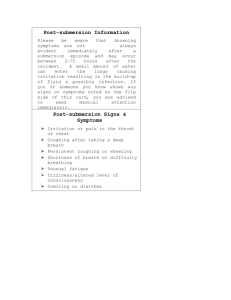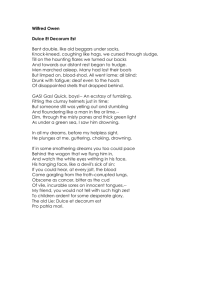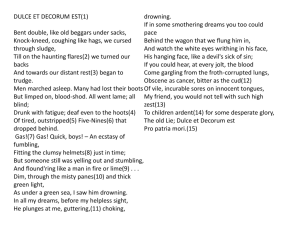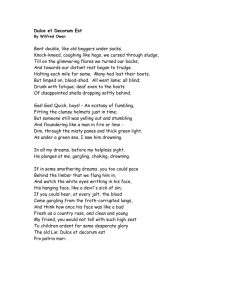Drowning
advertisement
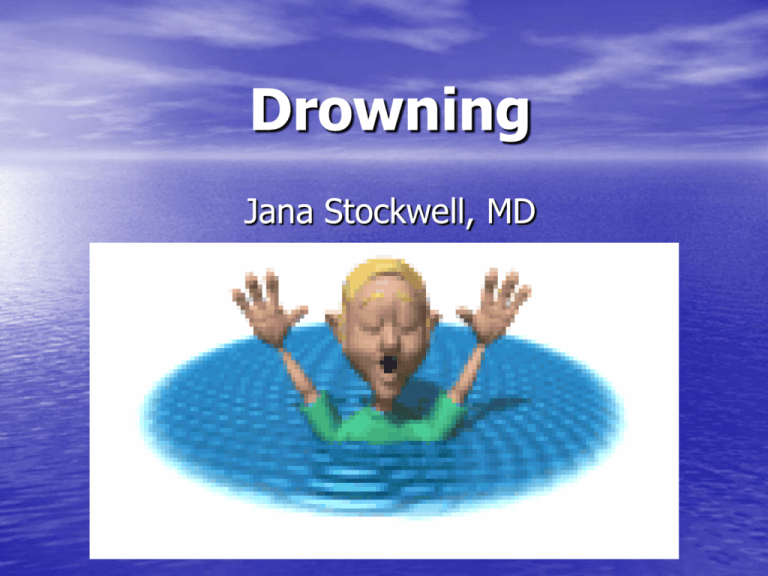
Drowning Jana Stockwell, MD Statistics • 1995 data: – >1000 kids <14 years old drown – 60% <4 years old • 2000 CDC data: – 3,281 unintentional drownings in USA (adults & kids) – averaging 9 people/day - not including boatingrelated incidents • 2003 CDC data: – For every child who drowns, 3 need ED care for nonfatal submersion injuries – >40% of these children require hospitalization 2002 World Congress on Drowning • Drowning = process resulting in primary • • • respiratory impairment from submersion/immersion in a liquid medium Regardless of survival Drowning without aspiration does not occur Terms which are “out” – Dry, wet, active, silent, secondary, near-drowning 1989-1998 CDC data >75%ile of National avg 50-75%ile of National avg 25-50%ile of National avg <25%ile of National avg Groups at Risk (2001 data) • Males: 78% of drownings in the United States • Children: 859 children ages 0-14 years died from drowning – Drowning rates have slowly declined – 2nd-leading cause of injury-related death for kids ages 1-14 years • African Americans: age-adjusted drowning rate for African Americans was 1.4 X higher (CDC 2003) Morbidity & Mortality • 15% of children admitted for drowning die in • the hospital As many as 20% of drowning survivors suffer severe, permanent neurological disability Drowning modalities • Infants (age <1) - • • bathtubs, buckets & toilets Children ages 1-4 years swimming pools, hot tubs & spas Children ages 5-14 years - swimming pools & open water sites (Brenner 2001) Bucket drownings • ~300 children in the US since • • • 1984 7-15 months of age 24 to 31 inches tall Bucket may contain water or nasty cleaning fluid Tub drownings • Approximately 10% of childhood drownings • Typically lacking adult supervision • Do tub seats help? Bathtub seats - ? or ? • Not intended or marketed as safety devices • Bathtub drowning deaths of infants aged 6-10 mo • • • • • from 1994-1998 40 infant drowning deaths associated with bath seats 78 deaths not associated with bath seats ~45% of infants in this age group use bath seats Data suggests seats either have no effect or they may provide some slight protection against unintentional bathtub drowning risks Odds ratio 0.6 [95% CI 0.4-0.9] Data: US Consumer Product Safety Commission & National Center for Health Statistics for US resident infants (1994-1998) Tub seat use Baby swim classes • Done to “teach” babies to float • No reported drownings in class • Several reports of hyponatremic seizures following class (How was school today?) • False sense of security? Pool/Spa drownings • Most residential pool drownings are in kids <4 yo • 3,000 pool drownings require hospital ED treatment each year – last seen inside the home – missing from sight <5 minutes – in the care of one or both parents at the time of the drowning • >50% occur in the child's home pool • 1/3 occur at homes of friends, neighbors or family • Since 1980, ~230 kids <4 yrs in spas & hot tubs (Present 1987, Brenner 2001) Cochran Review – Pool fencing • Meta analysis of case–control studies evaluating • pool fencing Results: – Pool fencing significantly reduces the risk of drowning • Odds ratio (OR) for the risk of drowning or near drowning in a fenced pool compared to an unfenced pool is 0.27 (95% CI 0.16 – 0.47) – Isolation fencing (enclosing pool only) is superior to perimeter fencing (enclosing property and pool) • OR for the risk of drowning in a pool with isolation fencing compared to a pool with three – sided fencing is 0.17 (95% CI 0.07 – 0.44). • In-ground swimming pools without complete 4- sided isolation fencing are 60% more likely to be involved in drownings than those with 4-sided isolation fencing Boat-related drownings • 2002 Coast Guard data, all ages: – 5,705 boating incidents: 4,062 injured, 750 killed – 70% of fatalities due to drowning – 30% of fatalities due to trauma, hypothermia, CO poisoning, or other causes – Alcohol was involved in 39% of fatalities – Open motor boats - 41% – Personal watercraft – 28% Alcohol • Involved in 25-50% of teen and adult deaths associated with water recreation (Howland 1995; Howland & Hingson 1988) • Alcohol influences balance, coordination, and • judgment, and its effects are heightened by sun exposure and heat (Smith and Kraus 1988) Relative risk of drowning was 31.8 in persons with a markedly elevated alcohol level (>21.7 mmol/L) and 4.6 for levels <21.6 mmol/L (Cummmings JAMA 281:2198, 1999) The event, part 1 • • • • • • Voluntary breath-holding Aspiration of small amounts into larynx Involuntary laryngospasm Swallow large amounts Laryngospasm abates (due to hypoxia) Aspiration into lungs The event, part 2 • Decrease in sats • Decrease in cardiac output • Intense peripheral • • • • vasoconstriction Hypothermia Bradycardia Circulatory arrest, while VF rare Extravascular fluid shifts, diuresis Diving reflex • Bradycardia, apnea, vasoconstriction • Relatively quite weak in humans – better in kids • Occurs when the face is submerged in very cold • water (<20°C) Extent of neurologic protection in humans due to diving reflex is likely very minimal Pathogenesis 1 • Asphyxia, hypoxemia, hypercarbia, & metabolic • • acidosis Fresh water vs salt water - little difference (except for drowning in water with very high mineral content, like the Dead Sea) Hypoxemia – – – – – Occlusion of airways with water & particulate debris Changes in surfactant activity Bronchospasm Right-to-left shunting increased Physiologic dead space increased Pathogenesis 2 • • • • Cardiac arrhythmias Hypoxic encephalopathy Renal insufficiency Global brain anoxia & potential diffuse cerebral edema Findings at autopsy • • • • • • Wet, heavy lungs Varying amounts of hemorrhage and edema Disruption of alveolar walls ~70% of victims had aspirated vomitus, sand, mud, and aquatic vegetation Cerebral edema and diffuse neuronal injury Acute tubular necrosis Signs & symptoms • 75% of kids who develop sxs do so within 7 • • • • • • hours of event Coma to agitated alertness Cyanosis, coughing, and the production of frothy pink sputum Tachypnea, tachycardia Low-grade fever Rales, rhonchi & less often wheezes Signs of associated trauma to the head and neck should be sought Prevalence of concomitant traumatic injuries • 143 drowned & near-drowned • • kids Median age 3.8 years (1 mo – 18.7 yrs) 30% with pre-existing disease – CHD, sz, MR/CP, DD • 5% with traumatic injuries – All boys – Older, mean age 13.5 years – 6 of 7 had C-spine injury from diving (H Shofer, Ann Emerg Med 2004) Labs & tests • Very mild electrolyte • • changes Moderate leukocytosis Hct and Hgb usually normal initally – Fresh water aspiration, the Hct may fall slightly in the first 24 hrs due to hemolysis – Increase in free Hgb without a change in Hct is common • DIC occasionally • ABG – metabolic acidosis & hypoxemia • EKG – Sinus tachycardia & nonspecific ST-segment and T-wave changes – Reverts to normal within hours – Ominous - ventricular arrhythmias, complete heart block • CXR – May be normal initially despite severe respiratory disturbances – Patchy infiltrates – Pulmonary edema Therapy for the lungs • • • • • CPAP or PEEP Aerosolized β-agonists for bronchospasm Bronchoscopy Prophylactic antibiotics have not been shown to be beneficial Steroids: – No controlled human studies to support use – Animal models and retrospective studies in humans have failed to demonstrate benefit Surfactant • Beneficial – Porcine surfactant (Curosurf) 0.5 ml/kg (40 mg/kg) IT for ARDS 8h after freshwater neardrowning in a 12yo (Acta Anaesthesiol Scand 2004) • Not beneficial – Submerged rabbits (A Anker, Acad Emerg Med 1995) – Kids (F Perez-Benavides, Ped Emerg Care 1995) Brain therapy • ICP monitoring - not indicated, typically irreversible • • • • • • • hypoxic cellular injury Brain CT – not indicated, unless TBI suspected Mild hyperventilation? Osmotherapy – not indicated Corticosteroids (dexamethasone) - no proven benefit Seizures - treat aggressively Shivering or random, purposeless movements can increase ICP Hypothermia and barbiturate coma - highly controversial & unlikely to benefit the patient (31 comatose kids, J Modell, NEJM 1993) Bad prognostic indicators • • • • Submerged >10 min Time till BLS >10 min CPR >25 min Initial GCS <5 • • • • Age <3 years CPR in ER Initial ABG pH <7.1 Initial core temp <33o Will the child die? Neurologic prognosis • Absence of spontaneous respiration is an • ominous sign associated with severe neurologic sequelae Permanent neurologic sequelae persist in ~20% of victims who present comatose – Minimal brain dysfunction, spastic quadriplegia, extrapyramidal syndromes, optic and cerebral atrophy, and peripheral neuromuscular damage Cold vs icy water immersion • Usually hypothermia is an unfavorable sign • Several case reports of dramatic neurologic recovery after prolonged (10-150 min) icy water submersions – Freezing-temperature water (<5°C) – Core body temperature less than 28-30°C, or much lower • For hypothermia to be protective, core body temperature must fall rapidly, decreasing cellular metabolic rate, before significant hypoxemia begins Hypothermia easier in kids • High BSA/mass ratio and subcutaneous fat • • insulation Moderate hypothermia (core 32-35°C) VO2 due to shivering thermogenesis & increased sympathetic tone Severe hypothermia (core <32°C) shivering stops & the cellular metabolic rate (~7%/°C) Hypothermia & brain protection • Effective in protecting the brain and other organs from anoxia for 75-110 min in controlled circumstances where core body temperature is cooled first to 18°C and then the heart is stopped – Deep hypothermic circulatory arrest (DHCA) • Once cell death from hypoxemia occurs (~5-6 min), no protective hypothermic effect or improve recovery Hypothermia – surface cooling • Surface cooling alone is cannot core temp fast enough to yield protection • Cooling rate in drowning victims is difficult to estimate as patient may also be swallowing or breathing in cold water • Cardiac anesthesia literature: – Surface cooling of anesthetized naked infants with ice packs and ice cold water decreases rectal temperature by ~2.5 °C in the first 10 minutes – Another 32 minutes for the temperature to fall to 24-26°C – During surface cooling in flowing water at 1°C the nasopharyngeal temperature of a naked infant (4 kg) falls 1°C every 5 minutes • Hypothermic protection involving surface cooling only would seem to require submersion in icy (not cold) water Does aspiration of icy water will accelerate the cooling process? • 80-90% of animals & human submersion victims • • in warm or cold water drownings aspirate very little (<2.2 ml/kg) Theoretically, a very large quantity of icy water would have to be aspirated or swallowed Immersion in icy water results in involuntary reflex hyperventilation and a decreased breath holding ability to <10 sec, increasing the likelihood of aspiration and rebreathing of icy water in some victims Ice water submersion - dogs • Rapid & violent hyperventilation lasts ~70 sec • Control animals submerged (ice water, head out • • • • of the water) carotid artery temp fell 0.8°C in 2 min Completely submerged dogs temp fell ~8.0°C during the first 2 min in both ice-water (4°C) Rectal temp lagged behind in carotid temp Victims of ice-water submersions more likely to have involuntary breathing & aspiration Brain may be cooled to a protective level (~<30°C) provided the water aspirated was icy & cardiac output lasts long enough for sufficient heat exchange to occur Cold water submersion - humans • Few cold water victims have significant brain • • protection Hypothermia is more commonly an unfavorable prognostic sign King County, WA (water is cold, but rarely icy) – Hypothermic protection has not been observed – 92% of good survivors had initial core temp of >34°C – 61% of those who died or had severe neurologic injury had core temp <34°C • Finnish study: – Median water temp 16°C – Submersion duration <10 minutes had greatest sensitivity in predicting good outcome, even in kids Re-warming • Re-warm 1-2oC per hour to range 33-36oC • Mild (32-35o) passive rewarming • Moderate (28-32o) – Shivering fails – J wave – Active internal/external rewarming (not extremities) • Severe (<28o) – – – – Appears dead, pupils dilated/NR VFib, extreme brady, pulseless Deep rectal or esophageal temps Maintain CPR until core temp >32o Warm water data - site • 274 patients • Age 6 months-15 years (mean 32 mos, median • • • 24 mos) 63% males Submersion witnessed in 12% cases Submersion site data (126 patients) – – – – 80% backyard pool or spa 11% in a bathtub 5% in a lake or pond 3% in other sites Warm water data - response • Bystander resuscitation – 80% patients • Average EMS respose time - 6.8 minutes • Upon EMS arrival – 76 (28%) children were in cardiac arrest – 13 (5%) with PEA • • • • Paramedic CPR - 87/89 children 18 (20% of those w/ CPR) no longer needed CPR in ED Paramedics intubated 19 children Epinephrine in 30 patients Warm water outcomes • Cardiac – 71 (80% of those in arrest @ scene) arrived to ED in cardiac arrest – 13 PEA – 5 deteriorated & required CPR – All 89 received Epi - (average duration 8.9 minutes, range 2 to 105 minutes) • 41 (46% of codes) survived (8 intact, 33 vegetative) • Longest CPR duration in an intact survivor was 47 minutes • Respiratory – 125 (46%) patients were intubated – 7 were apneic, 26 were breathing but comatose Warm water outcomes • CNS – Persistent deficits in 15 of the 185 functionally intact survivors – Initial ED GCS 3 in 100 kids • 14 survived intact – 165 patients having GCS 4 upon arrival in the ED • 2 survived in PVS • all others survived intact • 51 patients who subsequently died – Withdrawal 22 – Brain death 23 All intact survivors demonstrated functional recovery within 48 hours Warm water survival in kids • 6 studies reported functional recovery 17% (overall • average) of victims who required CPR in the ED Withholding or withdrawal of therapy from kids who have low probability of functional survival after warm water submersion injury has been suggested – Failure to respond to advanced life support within 25 minutes – Lack of purposeful movements or normal brain stem function @ 24 hrs – Anecdotal experience with spectacular recoveries & the small numbers of severely injured patients in most studies raises uncertainty about their predictive accuracy • Graf et al. suggested that outcome for pediatric submersion victims can be predicted with 4 measures: coma, absence of pupillary light reflex, admission blood glucose concentration (high) and sex Recommendations • Pre-hospital resuscitation, including early • • • intubation, ventilation, vascular access, and administration of advanced life support medications Continued resuscitation and stabilization in the ED Full supportive care in the ICU for a minimum of 48 hrs Consider withdrawal of support if no neurologic improvement is detected after 48 hours – Ancillary testing such as brainstem evoked responses, EEG, and MRI (not CT) may prove helpful to 1997 Christenson, Jansen, Perkins corroborate the neurologic Pediatrics, examination You can’t make this stuff up • • • • • 67 year old with pulmonary fibrosis S/P lung resection On ward, with O2 POD#2 developed distress, to ICU, intubated, ARDS… Finally extubates… (CHEST 2001; 120:1021-1022) Part deaux – a better history • Day after extubation, RN noticed patient's friend • • • attempting to submerge the patient's face in a waterfilled basin On questioning, patient indicated that he was aspirating water to clean sinuses and lungs, explaining that this was a daily routine for cleaning airways in his family He noted that on POD 1, while performing this ritual, he had a severe coughing and choking spell while his face was submerged This "technique" was witnessed by the housestaff, but not reported until directly questioned
